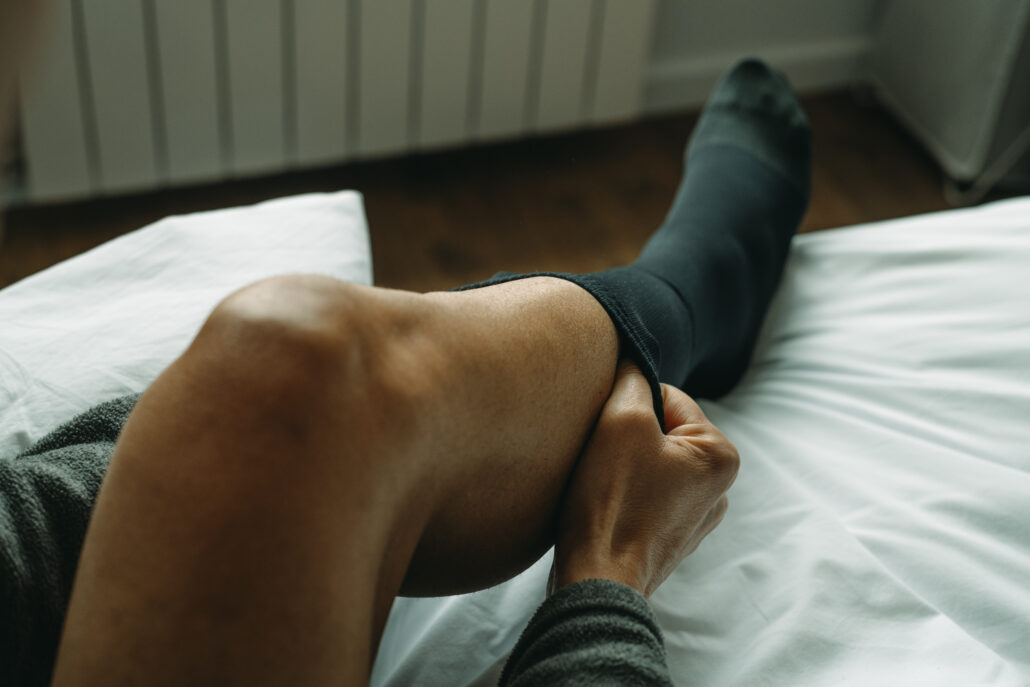Once relegated to helping people avoid blood clots after surgery and on long flights, compression socks seem to be having a moment right now. The number of social media posts and videos touting the benefits of compression socks has increased significantly. Yet, what’s the real scoop? Does wearing compression socks have health benefits?
“Compression stockings absolutely can be beneficial to control swelling, improve circulation, and help your feet and ankles feel better. They can be useful in patients who have chronic medical conditions that cause swelling, postsurgical patients, and even in the average person who has sore feet after a long day of standing and walking,” said Samuel Russ, M.D., foot and ankle orthopedic surgeon at Summit.
What are compression socks?
Compression socks are tight, sturdy stockings designed to gently squeeze the feet, ankles, and lower legs. Also known as compression stockings, they offer gentle to moderate pressure (i.e., compression) on your lower extremities, which translates to increased pressure on your legs’ blood vessels. By doing so, they can decrease fluid retention and swelling in your legs, ankles, or feet. They can also improve circulation in the lower limbs.
There are several different kinds of compression socks with various features:
- Some stop at the knee, while others go all the way up the leg
- Some have increased pressure at the ankle and less pressure farther up, while others have consistent pressure throughout
- They have different levels of compression
- Some qualify as specialty medical devices, and you may need a doctor’s prescription or a special fitting
Compression socks are widely available. You can find them in pharmacies, general retailers, and online stores. While some types of compression socks may require a prescription or a specialty fitting, there are many options available over the counter.
Who might benefit from compression socks, and under what circumstances?
Generally speaking, compression socks might be beneficial for people who:
- Have circulation problems
- Have lymphedema or other leg swelling
- Are not mobile
- Sit or stand for long periods of time
- Take long airplane flights
- Are pregnant
- Have certain types of leg pain
- Want to reduce muscle strain when exercising
- Are recovering from surgery
What are some tips for getting the most out of wearing compression socks?
For general, day-to-day use:
- Start wearing them in the morning, when your legs may be less swollen
- Roll them up slowly and carefully, starting at the ankle
- Avoid applying lotion before putting the stockings on
- Although it’s normal for compression socks to be uncomfortable at first, call your provider if you experience intense pain or leg discoloration
- Talk with your provider about how many hours a day you should wear the compression socks
“Compression stocking pressure is measured in millimeters of mercury (mm Hg). Most patients require low to moderate compression, between 10 and 30 mm Hg. Higher than that should be discussed with your healthcare provider,” Dr. Russ said.
Tips for postsurgical patients
If you have had surgery and are wearing compression stockings as part of your postoperative care, follow your doctor’s specific instructions. Here are some general recommendations from Summit’s team:
- Post-op patients are typically advised to wear compression socks for 20 out of 24 hours each day (overnight as well) for seven days
- Remove them before showering, and allow your feet to breathe for a few hours before putting them back on
- During this time, wash the stockings and hang them to dry
- Wear a compression sock only on the leg that was operated on to decrease inflammation
Talk with your healthcare provider or consult one of Summit’s specialists if you have questions.

